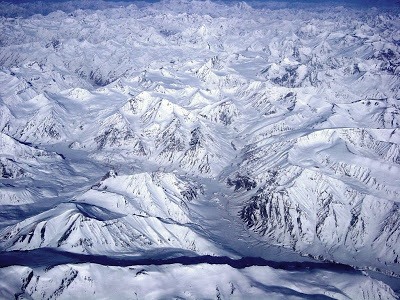Strengthening the belief of global warming, high altitude hills in
surroundings of Manali are losing their snow cover at unusual high temperature
and worse thing is that one can climb up to 15,000 feet even with a single
shirt. Yes this is impact of global warming, claim scientists.
surroundings of Manali are losing their snow cover at unusual high temperature
and worse thing is that one can climb up to 15,000 feet even with a single
shirt. Yes this is impact of global warming, claim scientists.
Snow has completely disappeared from 13,050 feet high Rohtang pass and tourists are
enjoying climbing here without proper woollens. Rohtang had received over 50
feet snow during winter months and snow accumulation here was about 35 feet in
first week of May when snow from Manali-Rohtang highway was cleared. According
to local trekkers and guides, despite heavy snowfall in this winter, snow cover
on all mountains including Deo Tibba, Hanuman Tibba and Seven Sister peaks is
very thin due to fast melting of snow.
enjoying climbing here without proper woollens. Rohtang had received over 50
feet snow during winter months and snow accumulation here was about 35 feet in
first week of May when snow from Manali-Rohtang highway was cleared. According
to local trekkers and guides, despite heavy snowfall in this winter, snow cover
on all mountains including Deo Tibba, Hanuman Tibba and Seven Sister peaks is
very thin due to fast melting of snow.

Mountainous regions of Lahaul-Spiti district, popularly known as cold deserts, are warmer
than Shimla, Nahan (Sirmaur) and many other low altitude regions. In July, the
average maximum temperature here is more than 25 degrees Celsius. Residents of
Lahaul-Spiti are wearing summer collections similar to Punjab. Snow has almost
disappeared from the adjoining peaks which otherwise used to work as coolant
for the valley.
“There are no sign of snow on Rohtang pass and it has melted away even on the higher
mountains,” Dhani Thakur, trekker and owner of Himalyan Eagle Adventures, said
who has been scaling the Himalayan mountains for last 15 years. He adds, “Certainly
the mountains had received heavy snowfall in winters but the snow accumulation
is decreasing very fast.”
mountains,” Dhani Thakur, trekker and owner of Himalyan Eagle Adventures, said
who has been scaling the Himalayan mountains for last 15 years. He adds, “Certainly
the mountains had received heavy snowfall in winters but the snow accumulation
is decreasing very fast.”
According to sources, most of the people in Manali and other hilly areas of Himachal are
now going for AC cars which was considered a stupid thing some years back. Residents
are now purchasing air conditioners for their homes. However the nights are
cool in inhabited mid and high hills with average minimum temperature at 15
degrees Celsius but scorching heat is of day is forcing people to take a dip in
cold water.
now going for AC cars which was considered a stupid thing some years back. Residents
are now purchasing air conditioners for their homes. However the nights are
cool in inhabited mid and high hills with average minimum temperature at 15
degrees Celsius but scorching heat is of day is forcing people to take a dip in
cold water.
Resident of Keylong, Sher Singh Bodh, said he had never observed the warm blowing winds
in the valley but gradual increase in temperature is worrying the residents. “Snow
on peaks is melting very fast and it could be observed easily by river Chenab
which is in spate and rising each day. It is unbelievable that most of us are
not used to fans but had to buy one,” he concerns.
in the valley but gradual increase in temperature is worrying the residents. “Snow
on peaks is melting very fast and it could be observed easily by river Chenab
which is in spate and rising each day. It is unbelievable that most of us are
not used to fans but had to buy one,” he concerns.
Dr Jagdish Chander, geography and environmental impact assessment scientist with Kullu
based Govind Ballabh Pant institute of Himalayan environment and development,
says common men too are now able to identify the signs of global warming which
is impacting their daily life. “It is true that Himalayas are getting warmer
gradually and fast melting of snow at populated areas is just an example. Extreme
cold in winters and high temperature in summers is caused by pollution and
increasing human intervention with nature,” he added.
based Govind Ballabh Pant institute of Himalayan environment and development,
says common men too are now able to identify the signs of global warming which
is impacting their daily life. “It is true that Himalayas are getting warmer
gradually and fast melting of snow at populated areas is just an example. Extreme
cold in winters and high temperature in summers is caused by pollution and
increasing human intervention with nature,” he added.
It is noticeable that Rohtang pass had experienced snowfall during June and July
months in last some years but conditions are quite opposite this year. Concerned
about the increasing temperature on mountains and receding glaciers, a high
level committee of scientists of Snow and Avalanche Study Establishment (SASE)
had an important meet in Manali to discuss the impact of global warming this
year.
months in last some years but conditions are quite opposite this year. Concerned
about the increasing temperature on mountains and receding glaciers, a high
level committee of scientists of Snow and Avalanche Study Establishment (SASE)
had an important meet in Manali to discuss the impact of global warming this
year.



Comments